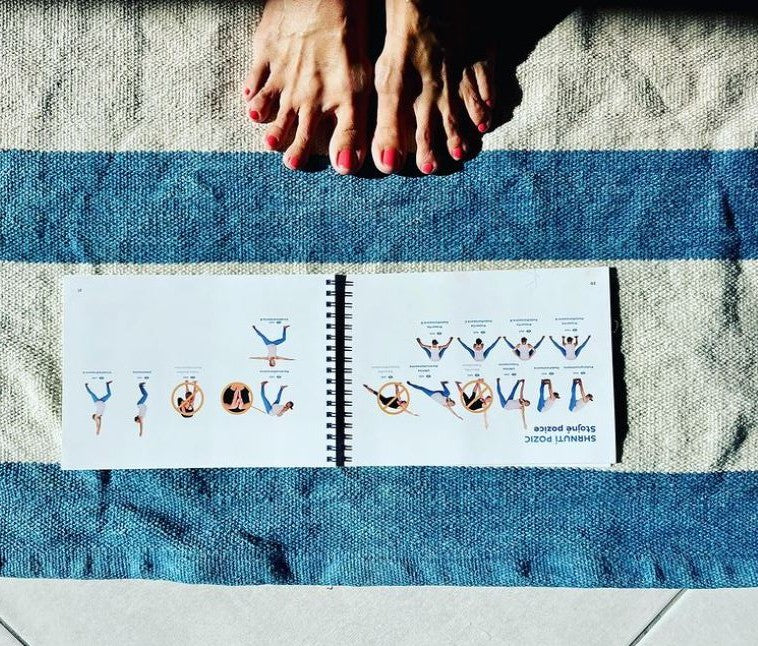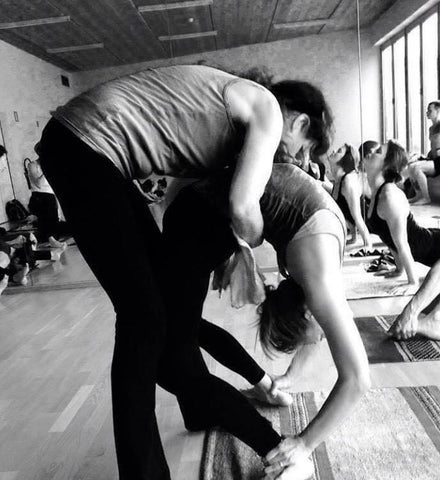
Yoga Practice on Yoga Rug, Why Do I recommend it? by Petra Visser
I have been using a yoga rug in my own Ashtanga practice since the very beginning, about 15 years ago. I immediately saw the difference in practice when I practiced in Newcastle. I asked the students and my teacher and bought it straight away.
I'll start with some recommendations, experience using yoga rugs, and also explain why I recommend Leela yoga rugs!
Since I am an Ashtanga yoga practitioner, I will write from this perspective. The yoga rug will also work for other types of yoga.

Source: instagram of Petra Visser
The most important thing to know about using a yoga rug in your practice is the difference between using a non-slip mat and a yoga rug
When you sweat on a non-slip surface, it slides more. When you sweat on the rug, you will feel safe and nothing will slip.
Many people are used to exercising on a sticky mat or something with "extra grip". It is important to know that the surface of a rug and underlay behaves differently when dry or when wet.
Some students start sweating right away, some take longer. Thanks to the deep and relaxed breath with the sound of ujjayi, we warm up internally and naturally the body starts secreting sweat. In winter, it is harder to warm up than in summer, and it will be different if you practice in India or in Hawaii, when it is already very hot in the early morning hours, compared to the practice of yoga here in the Czech Republic.
From my experience of practicing yoga on yoga rugs around the world, I can recommend:
- Spray some water on the rug where your feet and hands go and the rug will instantly have more grip. Just use the spray bottle that people use for the Kukkutasana pose :-). You can also add a few drops of essential oil to the water.
- In the Prasaritta Padottanasana position, you can fold the carpet in half. Some students like to practice all the same poses on the mat and then just roll out their mat. Spreading the rug when starting sitting positions is a common practice around the world.
- Leela yoga rugs: this rug is very soft, gentle yet firm. Unlike other carpets, it doesn't slip even before you sweat. The palms in Adho mukha svanasana (downward facing dog) hold beautifully and naturally in place.
Another important factor in how and when you use the mat in your practice is your own strength.
 Source: instagram of Petra Visser
Source: instagram of Petra Visser
You have "extra grip" on the non-slip mat. It is a technology that supports your body and removes some of the work that is necessary to support you, to gain strength. Work that, in my experience, is essential to a strong and healthy practice.
Natural cotton absorbs water well and also increases its strength by 30% when wet. Once your hands and feet start to sweat, you are less likely to slip on the surface of the fabric. A yoga mat helps you slide when you need to (during lunges, for example) and also supports you when you need it.
In Ashtanga yoga, we begin with the Sun Salutation and then the standing postures. A lot of people think it's just a warm up. I look at standing postures as a solid foundation of our practice. From my point of view, they are very important and provide the foundation and support for what is to come.
For some students, the grip of the mat may be necessary at first, you are not used to it and you need to gradually strengthen it with practice. Step by step. Don't worry if you are one of them, or if the pad really fits and works for you.
In my experience working with students, extra grip is one of the things that leads to back pain, but that's a bit of a different topic. Of course, every student is unique, so with the help of your teacher, decide what is best for you at this time. I met a student who switched to the yoga rug and immediately got rid of her back pain. She didn't have to change anything in her practice at all. The rug just works a little differently - it works with your body.
The problem with using carpet alone is that the surface of most yoga schools is laminate or hardwood.
When I practiced with my second teacher, Nancy Gilgoff, in Maui, she has a rug all over the floor in her shale, so I didn't need a mat at all and just folded my own rug straight away. However, the reality is that everywhere else in studios (and we honestly have hard floors everywhere at home too) the floor is slippery, you need a mat to put your rug on. The hardness of the floor is manifested in poses like Garbha Pindasana, where you will especially appreciate the softness of the carpet and mat underneath.
As for the pad, now that I mention it, I recommend the Manduka Pro. These pads are indestructible, so once you buy one, you won't need another in your life. Plus - once you try it, you'll really understand why it's the best. :-) Sometimes I lend mine to my students, I've had it for about 13 years, it's still like new. After they try it (under their rug), they are excited. I will then clean it again for myself from energies and impurities and any sweat.
Leela yoga rugs are softer than other yoga rugs, but I only have experience with the other two rugs I've practiced on. Therefore, I recommend here, either rely on me, or possibly try other carpets, so that you can compare yourself.

Source: instagram of Petra Visser
Is the yoga mat heavy or heavier ... Comparison with the yoga towel and Leela yoga rugs
Some people take the weight of the carpet as a disadvantage because they don't want to drag the carpet. You don't have to deal with this when practicing at home, and you usually already have your own place where you lay the carpet. When traveling, matching the carpet is sometimes a challenge. When I travel, I try to find the option that the rug always travels with me. I often get sms from students asking if mats are available in the studio and they only bring their carpet.
Since they are heavier (compared to a yoga towel), they stay in place better when you practice. Which is not quite so easy with a yoga towel. Leela yoga rug holds perfectly on the mat. You will notice the difference mainly when you make transitions in your vinyasas. However, a towel is a great option when you can't travel with a rug.
Leela yoga rugs are lightweight yet strong. You can easily fold them into your bag and they don't even take up that much space, which is another big plus.
How Yoga Rugs Matters (TO ME)
This is not important for everyone, so I won't preach what you should do, but for me it depends on what type of surface I do my spiritual practice on. I care about the material, where and how they are produced, and whether the person in question receives appropriate compensation for his work.
Leela yoga rugs are handmade and I myself use an organic yoga rug made of organic cotton. Only Ayurvedic herbs and fruits are used in the dyeing process. Thanks to natural vegetable dyes, the color tones are gentle on the eyes and skin. The carpet is hand-woven, soft, spacious, durable, absorbent and non-slip.
The Leela yoga mat is larger, so it provides a lot of space for yoga practice and does not move during exercise. It's the ultimate travel yoga mat - you can fold it or roll it up. Easy to carry and pack.

The Yog rug, is our place to which we return every day. He will be there for us when we fall (in life and in yoga practice), he is there for us when we need. Choose the best for yourself. After all, we practice 6 days a week with one day of rest. That is why the quality and the material we practice on are important.
Why we say 99% practice and 1% theory and my personal story can be found here on the blog.
I wish you a beautiful practice,
Namaste
By Petra Visser
